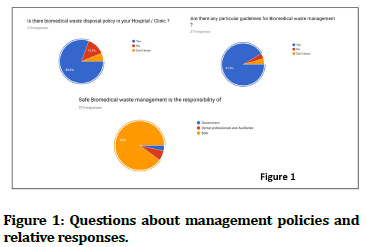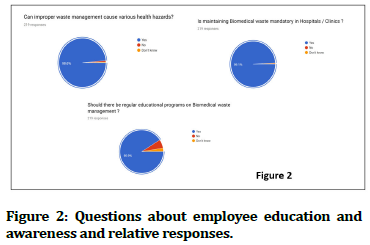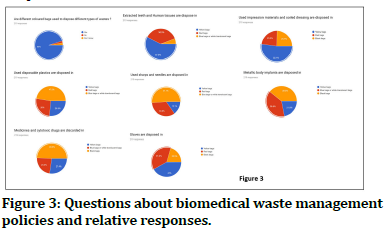Research - (2021) Volume 9, Issue 9
Awareness of Biomedical Waste Management among Dental Professionals
Ramvihari Thota* and Senthilnathan Periasamy
*Correspondence: Ramvihari Thota, Department of Oral & Maxillofacial Surgery, Saveetha Dental College, Saveetha Institute of Medical and Technical Science, Saveetha University Tamilnadu, India, Email:
Abstract
Aim: The aim of this study is to find out how aware the people from dental professionals are with the biomedical waste management. Method: The study was conducted among various dental professionals who include graduates and clinicians using a questionnaire. The questions were related to the biomedical waste management procedures they follow in their clinics or hospitals and their knowledge among the biomedical waste management. Results: In the aspect of biomedical waste management policies, there was a highly significant difference in the responses of the dental professionals whose answers suggested that regarding biomedical waste management practices, the dental professionals were significantly more aware of the method of waste collection in the hospital and employee education/awareness but were less aware of the disposal of various items into different color coded bags. Conclusion: The results of this study have demonstrated a lack of awareness of most aspects of biomedical waste management among dental professionals in the dental hospital/clinics.
Keywords
Biomedical waste, Biomedical waste management, Dental professionals
Introduction
During the health care process, healthcare establishments can and will generate lots of biomedical waste which is hazardous to humans and the environment. And is a major threat if there are poor biomedical waste management practices, which is a huge risk to the health of the general population, patients and healthcare professionals and contributes to environmental damage [1].
Definition of biomedical waste as per Biomedical Waste (Management and Handling) Rules, 1998 of India “Any waste which is generated during the diagnosis, treatment or immunization of human beings or animals or in research activities pertaining thereto in the production or testing of biological” [2]. In layman terms biomedical waste management means any waste that is generated during the process of diagnosis, treatment, and immunization of humans and/or animals.
The wastes are generated not only in diagnosis, treatment and/or immunisation but also during research or production or testing of biological materials. These wastes could be potentially health hazardous and cause damage to the environment if its management is indiscriminate. All hospitals and clinics are continuously at risk of potentially fatal infections like HIV (human immunodeficiency virus), HBV (hepatitis B) and HBC (hepatitis C) and more. To avoid this, a careful waste management system should be implemented in clinics and hospitals [3].
Biomedical waste is a global issue and the waste generated in hospitals is to be discarded and not intended for any further use in clinics or hospitals or research departments [4,5]. It is of great importance that several key aspects of biomedical waste and its management are addressed. This includes segregation of different types of biomedical wastes, use of colour coded bags for segregation of wastes and careful handling and transfer. For this adequate training and awareness programmes are required for medical and paramedical personnel [6].
Dental clinics and hospitals use materials and instruments that are directly exposed to saliva and blood and so they are potential sources of infection. Thus, it is necessary to investigate the level of awareness among dental professionals as a first step in minimising the threat from biomedical waste [7,8].
Aim
The aim of the study is to determine the awareness of biomedical waste management practices and policies among dental professionals.
Results
Figure 1 shows 91.3% answered yes for the question “are there any particular guidelines for biomedical waste management?” and the remaining 8.7% contains answers no and don’t know.
Figure 1. Questions about management policies and relative responses.
80.4% answered yes 13.2% answered no and the remaining didn't know the question “Is there biomedical waste disposal policy in your Hospital/Clinic?”
90% answered both and in remaining 10% few answered governments and remaining answered dental professionals and auxiliaries for the question “Safe biomedical waste management is the responsibility of”.
Figure 1. Questions about management policies and relative responses.
Figure 2 shows 98.6% answered yes and the remaining 1.4% answered no and didn't know the question “Can improper waste management cause various health hazards?”.
Figure 2. Questions about employee education and awareness and relative responses.
99.1% answered yes, 0.9% answered no and didn't know the question “Is maintaining biomedical waste mandatory in hospitals /clinics?”.
90.9% answered yes, 9.1% answered no and didn't know the question “Should there be regular educational programs on biomedical waste management?”.
Figure 2. Questions about employee education and awareness and relative responses.
Figure 3 shows 95% answered yes, 5% answered no and didn't know the question “Are different coloured bags used to dispose of different types of wastes?”.
Figure 3. Questions about biomedical waste management policies and relative responses.
36.5% answered red bags, 57.5% answered yellow bags and 6 % answered blue or white translucent bags for question “Extracted teeth and human tissues are disposed in”.
23.3% answered red bags, 52.1% answered yellow bags and 24.7% answered black bags for question “Used impression materials and soiled dressings are disposed in”.
26% answered red bags, 26.5% answered yellow bags and 47.5% answered blue or white translucent bags for question “Used disposable plastics are disposed in”.
33.8% answered red bags, 15.1% answered yellow bags and 51.1% answered blue or white translucent bags for question “Used sharps and needles are disposed in”.
21.9% answered yellow bags, 39.3% answered black bags and 38.8% answered blue or white translucent bags for question “Metallic body implants are disposed in”.
27.4% answered yellow bags, 49.3% answered black bags and 23.3% answered blue or white translucent bags for question “Medicines and cytotoxic drugs are discarded in”.
37.4% answered red bags, 42% answered yellow bags and 20.5% answered black bags for question “Gloves are disposed in”.
Overall, out of 219 responses only 5 answered all the questions correctly suggesting that only 2.28% of responses were correct.
Figure 3. Questions about biomedical waste management policies and relative responses.
The questionnaire that was followed in survey is as follows:
Awareness of biomedical waste management among dental professionals
Management policies
1. Are there any guidelines for biomedical waste management?
• Yes.
• No.
• Don’t Know.
2. Is there a biomedical waste disposal policy in your Hospital/Clinic?
• Yes.
• No.
• Don’t Know.
3. Safe Biomedical waste management is the responsibility of?
• Government.
• Dental Professionals and Auxiliaries.
• Both.
Employee education/awareness
1. Can improper waste management cause various health hazards?
• Yes.
• No.
• Don’t Know.
2. Is maintaining biomedical waste mandatory in Hospitals/Clinics?
• Yes.
• No.
• Don’t know.
3. Should there be regular Educational Problems on Biomedical waste management?
• Yes.
• No.
• Don’t Know.
Bio medical waste management practices
1. Are different coloured bags used to dispose of different types of waste?
• Yes.
• No.
• Don’t Know.
2. Is extracted teeth and human tissue are disposed of in.
• Yellow bags.
• Red bags.
• Blue/white translucent bags.
3. Used impression Materials and Soiled dressings are disposed of in:
• Yellow bags.
• Red bags.
• Black bags.
4. Used disposable plastics are disposed of in:
• Yellow bags.
• Red bags.
• Blue/white translucent bags.
5. Used sharps and needles are disposed in:
• Yellow bags.
• Red bags.
• Blue/white translucent bags.
6. Metallic body implants are disposed in:
• Yellow bags.
• Red bags.
• Blue/white translucent bags.
7. Medicines and cytotoxic drugs are discarded in:
• Yellow bags.
• Red bags.
• Blue/white translucent bags.
8. Gloves are disposed in:
• Yellow bags.
• Red bags.
• Blue/white translucent bags.
Discussion
It is the responsibility of health care facilities to protect the environment and public health therefore, training the healthcare professionals for effective biomedical waste management is a very crucial step [9,10]. Hospitals and clinics these days use a wide variety of drugs such as antibiotics, cytotoxic, radioactive substances which are ultimately part of hospital waste [11]. The introduction of disposables in hospitals caused a great increase in the quantity of biomedical waste [12].
The main concern regarding biomedical waste is mainly due to the presence of pathogens and their substances which adversely affects the human health and surrounding environment adversely.[9] There could be a notable number of pathogenic organisms and their substances in the waste, including strains of viruses and bacteria. Dental practice involves exposure to many hazardous materials which calls for proper segregation and disposal of biomedical waste [13].
Biomedical waste generated by hospitals can be broadly categorised as general, infectious, and non-infectious but hazardous wastes. Of this 75%-85% is non risk or general waste, which constitutes paper and plastic packs [14]. 10%-15% is infectious waste, which includes human anatomical waste, disposable plastics, and sharps however small the number of infectious wastes it poses direct and great threat to the health and hygiene of humans, animals and surrounding environment by transmitting bacterial, viral, fungal and/or parasitic diseases [5]. The remaining 5%-10% is non-infectious but hazardous waste which includes chemical, genotoxic and radioactive wastes however it can cause serious health hazards like burns, chromosomal aberrations, and carcinogenic effects [8,15].
Improperly segregated biomedical waste and its disposal mixing it with municipal waste can lead to possible exposure of infectious and fatal diseases to healthcare workers, waste handlers, public and other living things in the environment [16]. In India proper biomedical waste rules where propagated in 1998 by Ministry of Environment and forest, Government of India, under Environment Protection act 1986 to protect the Environment and Community from various health hazards of infectious wastes [13,17,18]. For proper implementation of these rules the health care professionals should possess adequate knowledge regarding source of biomedical waste and its proper disposal. As per National guidelines of biomedical waste rules propagated by Government of India, waste must be disposed of in different colour coded bags [18] as mentioned in below Table 1.
| Colour-Coding | Type of container | Waste category |
|---|---|---|
| Yellow | Plastic Bag | Human and animal waste, soiled dressing (impression material) |
| Red | Disinfected container/Plastic Bag | Microbiology and biotechnology waste, solid waste (disposal items other than sharps such as tubings, catheters, intravenous sets) |
| Blue/White translucent | Plastic bag/puncture-proof container | Waste Sharps |
| Black | Plastic Bag | Discarded medicines and cytotoxic drugs, incineration ash, chemical waste, liquid waste |
Table 1. T Schedule I & II of Biomedical waste (Management and handling rules) 1998.
The finding of this study suggests an urgent need to educate and train dental professionals in dental clinics and hospitals. Furthermore, suggested that a proper acceptable waste management educational programme must be included in the dental educational curriculum to give vital importance to this issue. Further studies are required on a large population to generalise the results in articulation and implementation of biomedical waste guidelines [19].
The results of the study will help develop a strategy for improving better biomedical waste management in hospitals and clinics. Biomedical waste management programs cannot be successfully implemented without effective willingness, motivation, co-operation, and knowledge from all sections of employees of the health care setting. A complete approach should be followed regarding the collecting, transporting, treating and disposing of biomedical waste. There should be sensitization of dental professionals and their employees to this issue with effective implementation of rules, which are vital for better future outcomes [20].
Conclusion
The results in this study show that there is a lack of awareness of most aspects of biomedical waste management among dental professionals who work in clinics/hospitals. Educational level, use of visual aids and availability of color coded bins/bags in the work area were identified as key factors for effective biomedical waste management. Regular training in waste management should be given for dental professionals and other health care professionals and should have access to biomedical waste management guidelines in their respective health care department. Periodic studies should be conducted in addition.
Acknowledgement
None.
Funding
No funding to declare.
References
- Hiltz M. The environmental impact of dentistry. J Can Dent Assoc 2007; 73: 59–62.
- Ministry of Environment & Forests (MoEF) Government of India. The Grants Register 2019; 506–506.
- Rudraswamy S. Hospital waste management training among the staff of dental teaching hospitals in Bangalore city: Hospital waste management. Anchor Academic Publishing 2014.
- Acharya DB, Singh M. The book of hospital waste management. 2003.
- Lavanya KM, Majhi P. Knowledge, attitude and practices (KAP) about biomedical waste management among hospital staff–A cross sectional study in a tertiary care hospital, Andhra Pradesh, India. J Community Health Management 2018; 5:32-36.
- Oweis R, Al-Widyan M, Al-Limoon O. Medical waste management in Jordan: A study at the King Hussein medical center. Waste Management 2005; 25:622–625.
- Rodriguez-Morales AJ. Current topics in public health. Books on Demand 2013.
- Cannata S, Bek M, Baker P, et al. Infection control and contaminated waste disposal practices in Southern Sydney Area health service dental clinics. Aust Dent J 1997; 42:199–202.
- Awasthi M. Biomedical waste management. Manual for Dent Hygienist 2018; 189–189.
- Raman U, Iyer V. Biomedical waste management issues. going green: A Manual of waste management for the dental practitioner 2007; 54–54.
- https://www.energy.gov/em/office-environmental-management
- Chatterjee P. Biomedical waste management. GRIN Verlag 2017.
- Malhotra N, Goel RN, Goel S. Biomedical waste (management and handling rules 1998). Manual Doctors Law 2013; 69–69.
- Ghom A. Infection control in dental office. Textbook of Oral Medicine 2010; 35–35.
- Prüss A, Giroult E, Rushbrook P. Safe management of wastes from health-care activities. World Health Organization, 1999.
- https://www.sciencedirect.com/book/9780323014830/a-consumers-guide-to-dentistry
- Capoor MR, Bhowmik KT. Current perspectives on biomedical waste management: Rules, conventions and treatment technologies. Indian J Med Microbiol 2017; 35:157–164.
- World Health Organization. Safe Management of Wastes from Health-care Activities. World Health Organization, 2014.
- Cuny E. Infection control in the dental office: A review for an infection control examination. 2009.
- Al Balushi AY, Ullah M, Makhamri A, et al. Knowledge, attitude and practice of biomedical waste management among health care personnel in a secondary care hospital of Al Buraimi Governorate, Sultanate of Oman. Global J Health Sci 2018; 10:70.
Author Info
Ramvihari Thota* and Senthilnathan Periasamy
Department of Oral & Maxillofacial Surgery, Saveetha Dental College, Saveetha Institute of Medical and Technical Science, Saveetha University Tamilnadu, Chennai, IndiaCitation: Ramvihari Thota, Senthilnathan Periasamy, Awareness of Biomedical Waste Management among Dental Professionals , J Res Med Dent Sci, 2021, 9(9): 107-111
Received: 14-Aug-2021 Accepted: 06-Sep-2021



